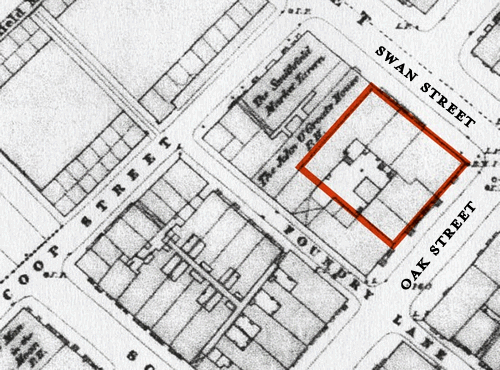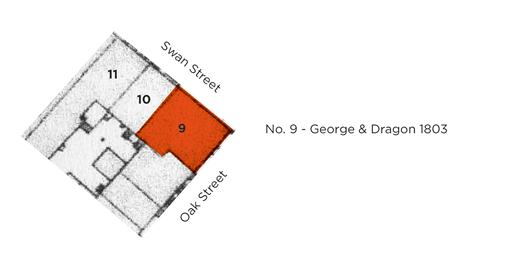Into the 19th Century
Into the 19th Century
Layout of the block
Leap forward over half a century and the Ordnance Survey map of 1850 shows a very similar buildings footprint to the block, but now The Smithfield Market Tavern and the John O’Groats House public house (to be renamed on a few occasions, now The Burton Arms) have been constructed. Here we see that the site that is currently occupied by Band on the Wall, including The Picturehouse, comprises no fewer than five conjoined premises, two each on Swan Street and Oak Street and one on the corner of both. Most probably they had continuously built up frontages, but with separate entrances, and were of two or three storeys, with cellars. The evidence from the street directories suggests that this layout of 1850 was already in existence before the turn of the century.

Figure 7 – Detail from Ordnance Survey Map 1850 (Manchester Archives & Local Studies). Outlined in red is the site of the present Band on the Wall, including The Picturehouse.
The first George and Dragon in Swan Street
In 1803, publican Elizabeth Marsh who had run a George & Dragon pub in Ardwick for at least eight years, opened her second George & Dragon at No 9 Swan Street, later to be renumbered several times as new buildings were constructed in the street. This small corner plot would remain the site of the George & Dragon throughout its long history but at various stages in the 19th century the pub would be considerably expanded as adjacent properties were annexed. In its early years, it must have been a modest operation, as it was some years before it merited inclusion in the trade directories. (Apparently first recorded in Dean’s Manchester Directory for 1808/09}

Figure 8 – The site of the first George & Dragon
Clearly No 9 Swan Street existed prior to its new life in 1803 as a public-house, but what was the building before that date? We cannot be certain but the street directories may throw some light on this. Generally, in these times these directories gave listings when a trade, profession or other occupation was being carried out at the address; also a few ‘principal inhabitants’ or ‘gentlemen’ might be listed but the ordinary occupants of ordinary dwellings were rarely included. A flour dealer, William Jefferson, was listed at 8 Swan Street in 1794 & 1797, on the other side of Oak Street, and in the same directories John Taylor is shown to have run his business as a corn dealer at No 10, next door to what would become the George & Dragon and later annexed as part of the pub. The absence of a listing in these directories for No 9 would suggest that at this time the small corner property that became the first George & Dragon was a dwelling, and the occupant was neither a ‘principal inhabitant’ nor a ‘gentleman’. Elizabeth Marsh, though a publican with two properties, did not fit either category.
Number 9 Swan Street is recorded in the Poor Law Rate Books and the details suggest that Mr Jefferson, the flour dealer, lived there in 1798 whereas by 1800 the rate for the premises was paid by John Smith, of the Griffin Iron Foundry, across Oak Street. At this time it would appear that No 11– probably on part of the site of The Picturehouse within the current, enlarged Band on the Wall – also was a dwelling, the home of the seemingly ubiquitous John Taylor, though a few years later it would also be a shop.9
At the start of the 19th century, Swan Street was already a busy little street, at the heart of an increasingly busy area. Though barely 300 yards long, already there were at least 26 addresses in the street, almost without exception all on the same side of the street.
Mixed use and live-in occupants
As stated, in the previous two decades much of the early speculative building in the Northern Quarter was in response to demand for housing for mill workers and domestic weavers. However, when Elizabeth Marsh opened the George & Dragon for business, Swan Street and its neighbouring streets were much more mixed use, at a level and diversity that no doubt would contravene health and safety regulations today. Houses, yes. Shops, yes. Warehouses, yes. But also trade and industry: the Griffin Ironworks, a coal yard, Hegginbottom’s Rope Yard, sawyers, joiners and chair makers – all on Swan Street. Just round the corner in Oak Street another pub and a surprising dual occupancy: an attorney, sharing the address with a bread baker. Yards away were the stables and blacksmiths in Foundry Lane. At No 1 Swan Street, at the corner with Oldham Street, was corn dealer Edward Swan who, like Mr Coop at No 1 Coop Street, is immortalised in the name of his street. A grocer, Edward Walker, also had his shop at No1.
Amid all of this industry and trade, hundreds of people lived – in Swan Street and adjacent streets at the beginning of the 19th century. While there were approximately as many dwellings as there were commercial premises, almost without exception the latter were also the homes of the traders, dealers, shopkeepers, etc; there were no lock-up shops or businesses in these days in this area: you lived on the premises,10 a practice that continued at the George & Dragon/Band on the Wall until 1979 and started there by Elizabeth Marsh 175 years earlier. The last live-in occupants in the upstairs rooms of Band on the Wall – now the offices of Inner City Music – were former licensee and partner in the business Frank Cusick and his wife Anne who lived and worked there from 1975 to 1979. Both are now deceased.






